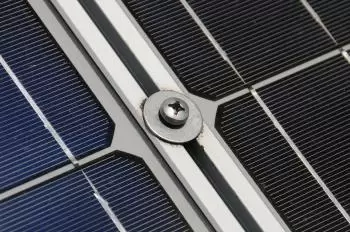
The photovoltaic effect is a fundamental phenomenon in the conversion of solar energy into electricity. It is characterized by the generation of an electric current when two different materials are in contact and exposed to light or electromagnetic radiation.
This effect is mainly activated by sunlight, although it can be triggered by natural or artificial light sources. However, in practice, the vast majority of photovoltaic panels use exclusively sunlight as an energy source.
The French physicist Alexandre-Edmond Becquerel was the one who discovered this phenomenon in 1839 while investigating the interaction between light and electricity, thus marking the beginning of the development of photovoltaic technology.
Use and applications of the photovoltaic effect
The photovoltaic effect is fundamentally used for the generation of electrical energy through the direct conversion of sunlight into electricity. This application materializes in technologies such as photovoltaic solar panels, which use semiconductor materials to take advantage of this phenomenon.
Semiconductor materials, such as silicon, are essential in this application due to their ability to take advantage of the photovoltaic effect. When photons of light impact these materials, they cause an excitation in the electrons, thus generating electric current.
Solar panels, made up of photovoltaic cells, are the pillar of this technology. These cells are made with semiconductor materials, generally pure silicon with controlled impurities, which maximize the efficiency of converting sunlight into electricity. This process is essential for obtaining clean and renewable energy, contributing significantly to climate change mitigation and energy independence.
How does it work
The photovoltaic effect begins when a photon hits an electron from the last orbit of a silicon atom. This last electron is called the valence electron and receives the energy with which the photon traveled.
The photon is the elementary particle that carries all forms of electromagnetic radiation, including solar radiation.
If the energy acquired by the electron exceeds the force of attraction of the nucleus of the silicon atom (valence energy), it leaves its orbit and is free. When free, the electron can travel through the conducting material forming a direct current.
Not all photons that reach solar cells are converted into electricity. Part of the incident radiation is lost by reflection (it bounces) and another part by transmission (it passes through the cell).
Photoelectric effect photovoltaic cells: current generation
Each freed electron leaves behind a hole, or free space, until it is filled by an electron that has jumped from another atom. These movements of electric charges (electrons) released from the spaces they leave behind are what is called electric current.
This current of charges can leave the material in order to perform useful work such as powering a motor, powering a light bulb, etc. For this to happen in a constant and regular manner, it is necessary that there be the presence of an electric field of constant polarity. This field polarizes the particles and acts as a true pump that drives the electrons in one direction and generates holes in the opposite direction.
In conventional solar panels, the electric field is formed thanks to the fact that one area of the material has an excess of electrons (negative charge), while the other has a lack of them (positive charge). In this way, when an electron is released, which has a negative charge, it is propelled through the material to the area where the charge is positive.
Importance of photons
Photons corresponding to small wavelengths (ultraviolet radiation) are more energetic than those corresponding to longer wavelengths (infrared radiation).
Each semiconductor material has a minimum energy that allows electrons to be released from their atoms. This energy will correspond to photons of a certain frequency band that will range from those associated with ultraviolet to visible colors, except for red, which already has an associated energy of less than 1.2 electron volts.
Why aren't all photons converted into electricity?
Not all photons achieve the goal of separating electrons. This is because photons lose energy as they pass through the material. Sometimes, at the moment of collision some photons have already lost too much energy to displace an electron.
Likewise, there is a percentage of photons that pass through the semiconductor sheet without encountering any electrons and others that are reflected. In these cases, the photovoltaic effect would not occur by making the electrons jump from one layer to another.